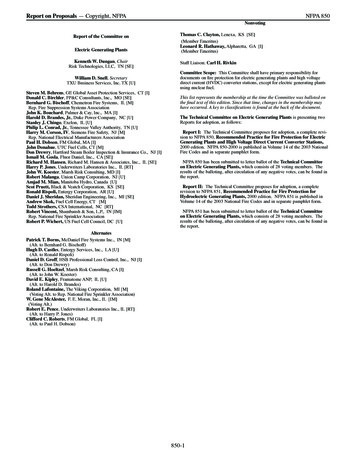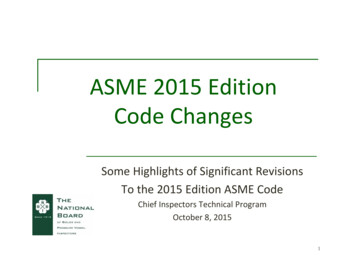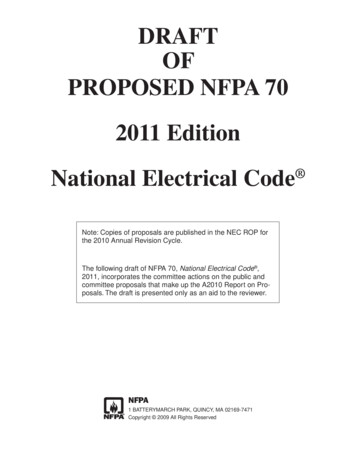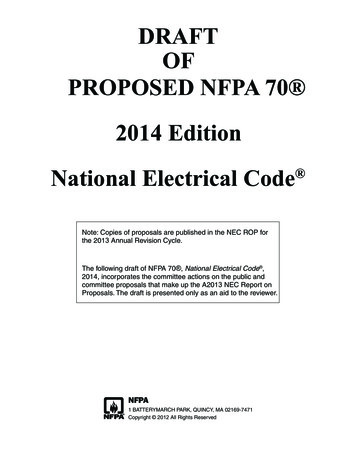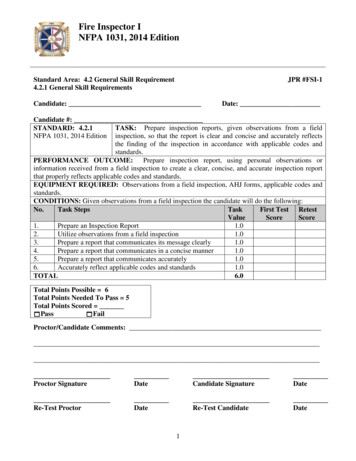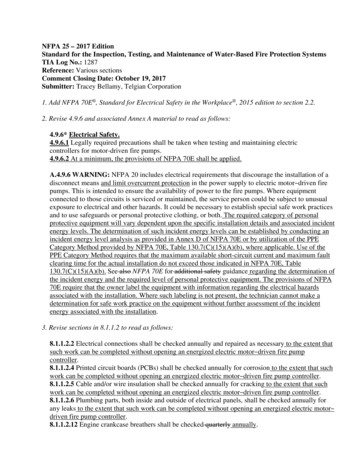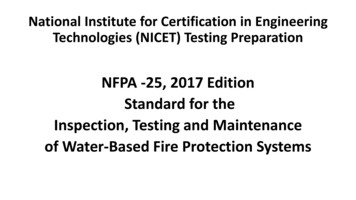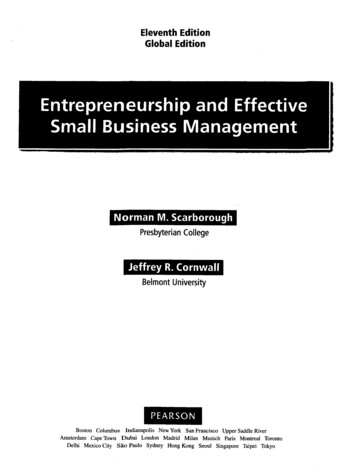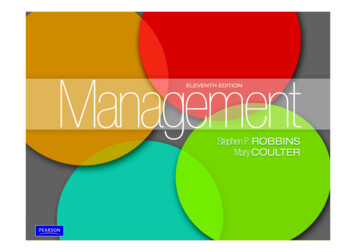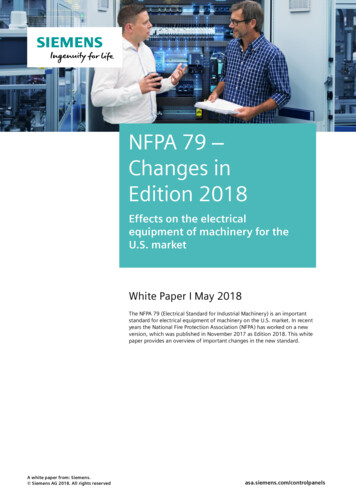
Transcription
NFPA 79 ‒Changes inEdition 2018Effects on the electricalequipment of machinery for theU.S. marketWhite Paper I May 2018The NFPA 79 (Electrical Standard for Industrial Machinery) is an importantstandard for electrical equipment of machinery on the U.S. market. In recentyears the National Fire Protection Association (NFPA) has worked on a newversion, which was published in November 2017 as Edition 2018. This whitepaper provides an overview of important changes in the new standard.A white paper from: Siemens. Siemens AG 2018. All rights reservedasa.siemens.com/controlpanels1
White Paper NFPA 79 Edition 2018 - Electrical Standard for Industrial Machinery May 2018Contents3-4Connection between NEC and NFPA 794444General information on NFPA 79Definition of industrial machineryScope of NFPA 79Differentiation between NFPA 79 and UL 508A5-65555Changes in NFPA 79, Edition 2018Important changes at a glanceIncrease of maximum voltage to 1000 VChanges in Chapter 3 "Definitions" and Chapter 4"General Requirements and Operating Conditions"New features in Chapter 5 "Disconnecting Means"Possible exceptions related to door interlockingOvervoltage protection devices for safety interlockcircuits66A white paper from: Siemens. Siemens AG 2018. All rights reserved6Summary7Further information from Siemens!2
White Paper NFPA 79 Edition 2018 - Electrical Standard for Industrial Machinery May 2018Connection between NEC and NFPA 79The National Electrical Code (NEC) is deemed to be theoverriding code for electrical installations in the USA. TheNEC is legally recognized as state of the art. It musttherefore be strictly adhered to and serves as the basis forapproval by the AHJ (Authorities Having Jurisdiction).Electrical equipment is not permitted to be put intooperation in the USA without approval of the AHJ.NFPA 79 together with UL 508A (Industrial Control Panels),to which the NEC refers in Article 409, forms an importantbasis for ensuring compliance with the technicalrequirements for electrical equipment of machinery in theUSA and in countries that apply U.S. standards.A new version of the NEC is published by the NFPA asNFPA 70 every three years. The current version is NEC 2017.Article 670 of the NEC specifically addresses "IndustrialMachinery". For additional information, the NEC refers tothe NFPA 79 ‒ Edition 2015, which was replaced by Edition2018 in November 2017.§Article 670NFPA 79Industrial Machinery§Article 409UL 508AIndustrial Control PanelsA white paper from: Siemens. Siemens AG 2018. All rights reserved3
White Paper NFPA 79 Edition 2018 - Electrical Standard for Industrial Machinery May 2018General information on NFPA 79Definition of industrial machineryAccording to NEC, Article 670.2 and NFPA 79, Chapter3.3.57, industrial machinery is understood to be a powerdriven machine (or a group of machines working together ina coordinated manner), that is not portable by handwhileworking and that is used to process material bycutting, forming, pressure, electrical, thermal or opticaltechniques, lamination, or a combination of theseprocesses.The following equipment can be part of the machineryequipment for Material transport Provision of tools, including fixing elements Assembly or disassembly Inspection and testing PackingThe associated electrical equipment, including a controllerwith associated software, and associated actuators andsensors are viewed as part of the machinery.Scope of NFPA 79NFPA 79: Because the machine supply and control panel supplygenerally involve the same supply terminal, it is possible toapply both standards to control panels.If possible, it should therefore be agreed in advance withthe user which standard is relevant. In practice, however,this cannot always be clarified beforehand. In this case, it isrecommended to comply with both standards.This does not pose a major problem because the twostandards are not contradictory and most requirements areidentical or similar. However, in some cases it can happenthat one standard allows less room for interpretation ofrequirements than the other one. In this case, it isrecommended to comply with the more stringentrequirement.Example: According to NFPA 79, a maximum of 120 V AC or250 V DC generally applies to control circuits. According to UL 508A, a maximum of 600 Vapplies to Class 1 control circuits. Voltages according to NFPA 79 are also acceptableaccording to UL 508A.applies to the use of electrical and electronicequipment, apparatus and systems of industrialmachines with a maximum nominal voltage of 1000 Vapplies commencing at the point of connection of thesupply to the machine guarantees safety for people and property does not apply retroactively, but must be appliedto changes (except repairs) of existing machinery does not apply to machinery in hazardousareas must not be applied to:1. fixed or portabletools judgedunder the requirementsof a testing laboratory, which is acceptable tothe authorities having jurisdiction;2.Machinery in dwelling unitsDifferentiation between NFPA 79 and UL 508AThe scope of NFPA 79 begins at the supply point of themachinery and ends at the loads in the machineryfield. The scope of UL 508A begins at the supply point ofthe control panel and ends at the field wiring terminals tothe machinery field.A white paper from: Siemens. Siemens AG 2018. All rights reserved4
White Paper NFPA 79 Edition 2018 - Electrical Standard for Industrial Machinery May 2018Changes in NFPA 79 ‒ Edition 2018Important changes at a glance Adaptation of the maximum voltage to the NECfrom600 V to 1000 V Partial revision of Chapter 3 "Definitions" and Chapter4 "General Requirements and Operating Conditions" Chapter 5 was renamed from "Incoming Supply CircuitConductor Terminations and Devices for Disconnectingand Removing Power" to "Disconnecting Means" andrevised New requirements for use of “Surge Protection Devices(SPD)” Chapter 8 was renamed from "Grounding" to"Grounding and Bonding" and revisedThe following section examines the above-indicated itemsin more detail.Increase of maximum voltage to 1000 VThe NEC 2014 distinguishes between electrical equipmentup to 600 V and over 600 V. With publication of NEC 2017,voltage ranges have been defined as up to 1000 V and over1000 V.The changes in Chapter 4 are limited in scope. However,Chapter 4.3 was newly added. It explicitly indicates that"listed" or "labeled" equipment must be used in accordancewith all the instructionsrelated tothe listing and labeling.New features in Chapter 5 "Disconnecting Means"Besides the renaming of Chapter 5 to "DisconnectingMeans", some of the descriptions have been precised ornewley added.For example, it is not only talked about the incoming supplycircuit conductor terminations anymore, but rather aboutmachine supply circuit conductor terminations. The supplycircuit disconnecting (isolating) means is now called themachine supply circuit disconnecting (isolating) means.If a machine is supplied by more than one supply circuit,Chapter 5.3.1.1.1 requires each supply circuit disconnectingmeans to be marked with a note indicating which part ofthe machinery is disconnected. This makes it clear to theuser that, by disconnecting the respective disconnectingmeans, the machinery is not completely de-energized andonly the respective part of the machinery is disconnected.This rule is not new but was recently expanded in Edition2018 with the addition of the new Chapter 5.3.1.1.2.In NFPA 79, Edition 2018, the voltage level was adapted tothe NEC and likewise increased from from the previousmaximum level of 600 V to 1000 V.Changes in Chapter 3 "Definitions" and Chapter 4"General Requirements and Operating Conditions"Chapter 3 of the NFPA 79 describes the meaning of manyterms. In Edition 2018, some terms were removed, newlyadded or revised. The terms "Attachment Plug (Plug Cap)(Plug)", "Receptacle" and "Socket" described in Edition 2015were removed, while other term definitions such as"Adjustable Speed Drive", were revised in Edition 2018,Chapter 3.3.5.The following term definitions were newly added in Edition2018: Standard Adjustable Speed Drive System Basic Protection Effective Ground-Fault Current Path Fault Protection Machine Supply CircuitA white paper from: Siemens. Siemens AG 2018. All rights reservedSupply circuit disconnecting means for drive motors5
White Paper NFPA 79 Edition 2018 - Electrical Standard for Industrial Machinery May 2018NFPA 79 distinguishes now even more clearly than beforebetween machinery with multiple supply circuits andmachinery with only one supply circuit. Thus, according toChapter 5.3.1.1.2, the main disconnecting means ofmachinery with only one supply circuit, which hasadditionaldisconnecting means on the output side, i.e. to disconnectparts of the machine, must now be marked as "MachineSupply Circuit Disconnect". This makes it clear to the userthat, by disconnecting the main disconnecting means, themachinery, possibly with the exception of circuits tappedupstream of the main switch (e.g. for lighting), iscompletely de-energized.However, the first exception allows that an enclosure thatprevents direct access to devices (other than handles ofcircuit breakers or switches) through a dead-front cover isnot required to be interlocked with the supply circuitdisconnecting means. The prerequisite is that the enclosurecan be opened only with a key or a tool and that acorresponding safety sign is attached to the enclosure inaccordance with Chapter 16.2. The sign must drawattention to the fact that the enclosure contains livecomponents and access to the enclosure is limited toqualified persons only.Overvoltage protection devices for safety interlockcircuitsAnother important change in NFPA 79 Edition 2018compared to Edition 2015 refers to the use of surgeprotection devices (SPDs).While Chapter 7.8.1 of Edition 2015 allowed, but did notprescribe, the use of SPDs, Edition 2018 explicitly requiresSPDs for circuits that supply safety interlock circuits.Find out morre about overvoltage protection devices undersiemens.com/overvoltage-protection.Supply circuit disconnecting means for machine supply circuitThe exceptions have also been specified in more detail inChapter 5.3.1.3. This part of NFPA 79 requires that thesupply circuit disconnecting means of each power supplycircuit with the exception of plug / socket combinationsmust be mounted within the control panel enclosure itselfor directly adjacent to the enclosure.There are two exceptions, however. These allow the supplycircuit disconnecting means of feeders for control panels tobe mounted up to 6m or 20ft away from the control panelenclosure. The prerequisite is that the supply circuitdisconnecting means must be in sight of the control panelenclosure and be easily accessible. Door interlocking isoptional for a control panel power of less than or equal to 2hp. Over that value, the control panel doors must beinterlocked with the main disconnecting means.These exceptions also existed in Edition 2015. However, therequirement that the location of the supply circuitdisconnecting means has to be marked on the control panelenclosure is a new addition.SummaryOverall, it can be stated that there are no drastic changes inthe new Edition 2018, but predominantly formulations orspecification of some requirements. In addition, it can beobserved that NFPA 79 and IEC 60204-1 resemble graduallymore and more, which certainly makes things easier formanufacturers operating internationally.Possible exceptions related to door interlockingThe first exception in Chapter 5.3.1.4 represents anotherimportant change. This chapter specifies that all controlpanels, which include supply circuit disconnecting meanswithin the enclosure itself or directly adjacent to theenclosure, must be interlocked in order to limit the accessonly to qualified persons.A white paper from: Siemens. Siemens AG 2018. All rights reserved6
White Paper NFPA 79 Edition 2018 - Electrical Standard for Industrial Machinery May 2018Further information from Siemens!Siemens keeps you up-to-date.Whether you are looking for reference works, web-basedtraining courses, helpful engineering tools or usefulinformation on panel building, you will find comprehensiveinformation on "expert know-how", "tools and data fordigitalization in engineering" and "aligned product andsystem portfolio" on our market portal for panel building:usa.siemens.com/controlpanelsStill have questions or need additional support?Siemens supports panel builders with free consulting andtraining on standards. Get in contact with one of ourexperts by sending us an email to:controlpanelquestions.us@siemens.comSiemens Industry, Inc.Digital Factory Control Products5300 Triangle Parkway NWNorcross, GA 30092A white paper from: Siemens. Siemens AG 2018. All rights reserved7
The NEC 2014 distinguishes between electrical equipment up to 600 V and over 600 V. With publication of NEC 2017, voltage ranges have been defined as up to 1000 V and over 1000 V. In NFPA 79, Edition 2018, the voltage level was adapted to the NEC and likewise increased from from the previous maximum level of 600 V to 1000 V. Changes in Chapter 3 "Definitions" and Chapter 4 "General .

